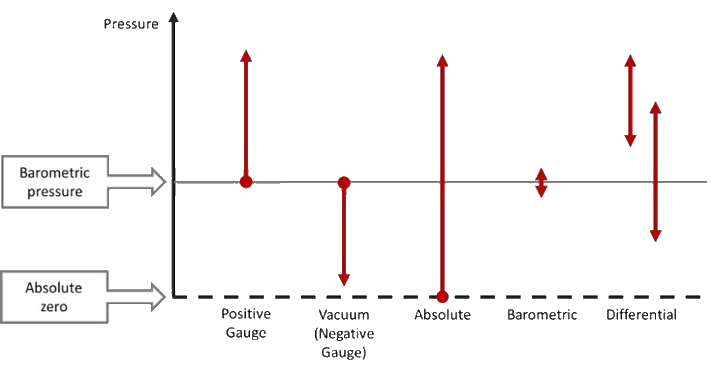PRESSURE CALIBRATION:
Pressure calibration covers the calibration of Pressure indicating device or Pressure gauge and Pressure transducer/ transmitter.
Pressure gauges are instruments used to measure the pressure of liquid or gaseous materials by calculating the force they would exert at a state of rest. Pressure is defined as the force exerted per unit area. The gauge displays the difference between the pressure in the area being measured and that of the surroundings, called the gauge pressure. The absolute or total pressure of the area will be the sum of the pressure difference measured by the gauge and the atmospheric pressure.
In everyday situations, we don’t usually talk much about different pressure types, but there are different types (sometimes also referred as “modes”) available. Explanation of the different pressure types are given below:
- The two principal pressure types are gauge and absolute pressure.
- Vacuum is sometimes considered as its own pressure type, although it is a negative gauge pressure.
- Barometric pressure is also used being the atmosphere’s absolute pressure.
- Differential pressure is also considered a pressure type as being the difference of two separate pressures. In the end, all the pressure types are differential, with just a different point of comparison. Let’s have a quick look at these different types.

Gauge pressure
Gauge pressure is the most commonly used pressure type. With gauge pressure we always compare the pressure we are measuring against the current atmospheric pressure. So it is the difference of the measured pressure and the current atmospheric pressure, meaning that we are that much above (or below) current atmospheric pressure.
Absolute pressure
Absolute pressure is the pressure compared to absolute vacuum, so it is the difference of the measured pressure and the absolute vacuum. An absolute vacuum is a state where the vacuum is so deep that there is no air molecules left, so there is no pressure. In practice a perfect absolute vacuum is impossible to achieve, but we can get pretty close. Also, in outer space, the pressure is absolute vacuum. An absolute pressure can never be negative, or in practice not even zero. Absolute pressure should be indicated as word “absolute” after the pressure reading (e.g. 150 psi absolute). Sometimes we can see also abbreviations “a” or “abs” being used, but the whole word “absolute” should be used if there is a risk that ”a” or "abs" can cause confusion in combination with the pressure unit.
Vacuum pressure
Vacuum pressure is a (gauge) pressure which is below current atmospheric pressure. Being a gauge pressure, it is compared against the current atmospheric pressure and is often indicated as negative gauge pressure. The term vacuum is sometimes also used as a generic term to refer to a pressure that is below atmospheric pressure, even if it could also be measured as absolute pressure. In that case it is of course not a negative number, it is just an absolute pressure being smaller than the current atmospheric absolute pressure.
Differential pressure
As the name already hints, the differential pressure is a difference of two separate pressures. The value can be positive or negative (or zero) depending upon which of these two pressures is higher. A common industrial application is the measurement of flow by comparing a differential pressure over a constriction in the tubing (usually zero-based), or a tank level measurement by measuring the differential pressure between tank top and bottom. Another common measurement is the very low differential pressure difference between a clean room and surrounding areas.
Barometric pressure
The barometric pressure is the absolute pressure of current atmospheric pressure at a specific location. The nominal barometric pressure has been agreed to be 101.325 kPa absolute, 1013.25 mbar absolute or 14.696 psi absolute. The barometric pressure is dependent on weather conditions, your location and your elevation, being the highest at sea level elevation and lowest at high mountains.
Calibration of Pressure gauge
Calibration of Pressure gauge is done by comparison method utilising a standard pressure gauge having minimum four times better accuracy than the pressure gauge being calibrated and a pressure pump generating and transmitting the same pressure simultaneously to the standard pressure gauge and the pressure gauge under calibration.
The pressure generating device may be pneumatic or hydraulic depending upon the amount of pressure required to be generated. A vacuum pump is required for generating requisite pressure below atmospheric pressure. Calibration of very high range of pressure gauge is done using dead weight tester utilising calibrated standard dead weights.
|